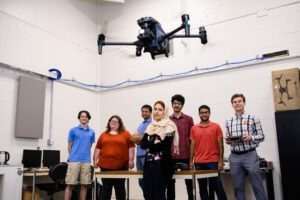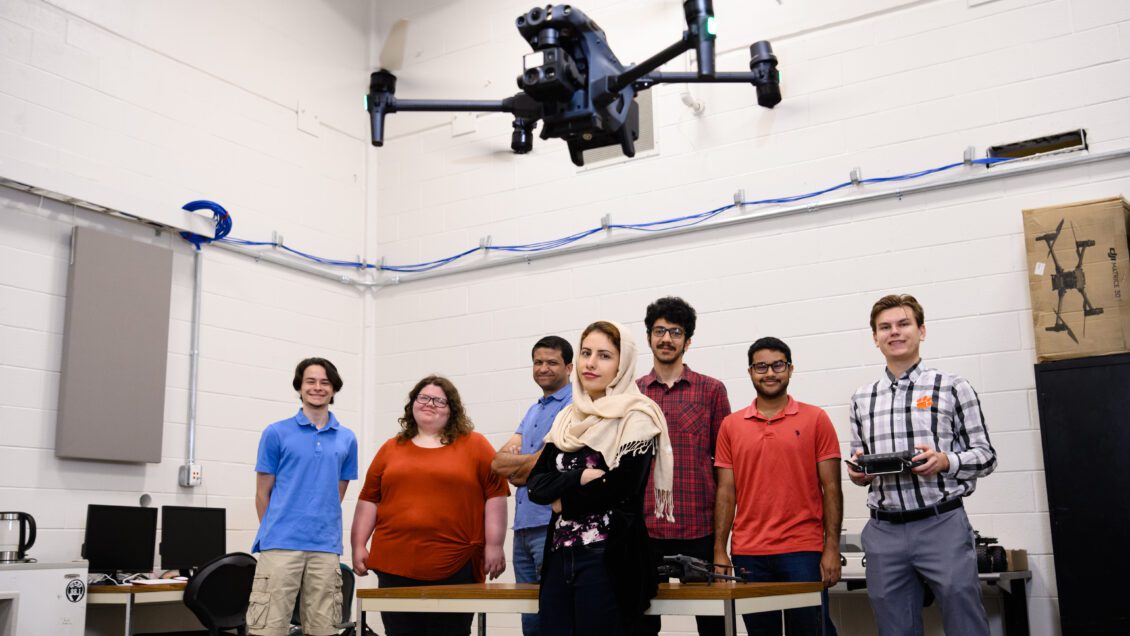Imagine a world where drones are continuously monitoring forests for wildfires, distributing relief to disaster zones and covering vast amounts of territory in search-and-rescue operations.
This is no flight of fancy– Fatemeh Afghah of Clemson University is playing a central role in bringing the vision closer to reality.
Afghah is an associate professor of electrical and computer engineering who is working to make drones smarter and better able to operate independently in places where it’s tricky to do so. She said drones, often called unmanned aerial vehicles (UAVs), could be a frequent sight in the sky in as little as a decade.
She and her team work in the Intelligent Systems and Wireless Networking (IS-WIN) Laboratory on Clemson’s main campus to answer critical questions that are helping open the skies to wider use of UAVs. Those questions include how UAVs can communicate where cell service is spotty or unavailable and how they can harness 5G without disrupting other users, such as self-driving cars and people on their phones.
Afghah sees a future in which fleets of small, low-cost UAVs work together with minimal human involvement.
“They need to operate autonomously, and that operation needs to be really stable, even if you don’t have any sort of communication with them,” Afghah said. “They need to operate safely, so that’s what we are helping make possible.”
Among her students is Bryce Hopkins of Aiken, who started working with Afghah as an undergraduate and decided to pursue a master’s degree under her.
As part of the group’s research, Hopkins had the opportunity in October 2022 to serve as a pilot during a prescribed burn in Oregon’s Sycan Marsh Preserve. He camped out for five days and worked with a team to capture spectacular aerial video of the flames licking at the trees.

“Dr. Afghah has a fairly hands-off approach,” Hopkins said. “She definitely gives us a lot of room to explore what we want to explore and provides support along the way. I definitely would recommend the IS-WIN Lab.”
Afghah and her team have also tested their wildfire-monitoring abilities using a drone equipped with thermal imaging during a prescribed burn in northern Arizona, where they collected data that they are using to train computer models.
Adding infrared has allowed the team to identify wildfires with 94% accuracy, Afghah said.
She envisions a future in which fleets of drones will be based at solar-powered wireless-charging stations deep in the wilderness and will monitor their areas when the fire risk is high.
Afghah first became interested in electrical engineering as an undergraduate. For her Ph.D. at the University of Maine, she focused on wireless communication and how cellular devices could work together cooperatively.
Later, as a tenure-track faculty member at North Carolina A&T and then Northern Arizona University, she shifted her focus to biomedical signal processing and medical device development. That work led her to machine learning, and she saw the potential for smart devices.

She got interested in how the technology could be applied to flight and drones in 2016-17 while working as a visiting faculty member with the U.S. Air Force. She brought that knowledge and experience with her to Clemson in August 2021, when she arrived from Northern Arizona.
Afghah has received funding from a variety of federal agencies throughout her career, including a 2019 Young Investigator Award from the Air Force Office of Scientific Research and a 2020 CAREER award from the National Science Foundation.
Recent grants from the National Science Foundation and NASA are funding work into how drones can complement cellular networks in 5G and eventually 6G. Afghah said she looks forward to collaborating with colleagues in the autonomous vehicle industry.
With UAV technology and FAA regulations evolving, Afghah sees a busy future for the skies above.
“In 10 years, people are going to have their own drones, and they are going to have very cool applications for them,” she said. “Drones will be more than machines in the sky– they will be aiding us in places we can’t reach and tasks once thought impossible. That’s the future IS-WIN is not just envisioning but engineering.”
Get in touch and we will connect you with the author or another expert.
Or email us at news@clemson.edu

